Of the more than 100 different cheeses produced in Spain, 27 are protected by the "Denominación de Origen Protegida" (D.O.P.) label. In English the most widely used expression which means the same is the description "P.D.O" - Protected Designation of Origin. Several others are still waiting for this status to be granted to them by the Ministry of Agriculture.
In Spain all varieties of cheeses are made: from fresh to extra cured; coagulated with the help of enzymes, lactic acid or a mixture of both; of diverse sizes and shapes; with rinds of various colours, engraved with splendid designs and patterns, covered with mould, smoked, spiced or rubbed with oil. It really is a world of scent and flavour.
Spanish cheese-makers use three types of milk: from sheep, cows and goats. Blends of these kinds of milk are also used to produce their cheeses. This great variety of cheese comes as a result of climatic and geographical differences and from farming customs steeped in age-old traditions. You will find in this pages all of the most important characteristics of all D.O.P. cheeses, as well as those of the most representative cheeses of each category: sheep's milk cheese, cow's milk cheese and goat's milk cheese in addition to various blends and blue cheese, in a sampling of our enormous cheese heritage, which is a reserve of our culture and traditions and places us among the most important cheese-producing countries in the world. Here are the top 10:
Queso Manchego
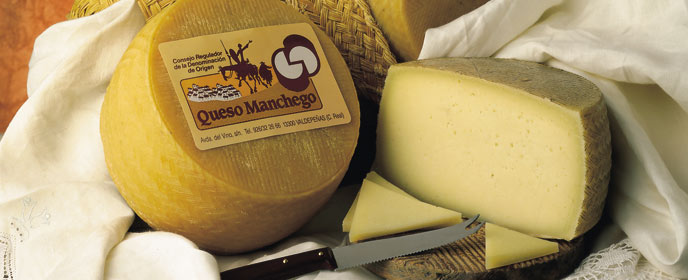
The Manchego is produced in the La Mancha region of Spain, which is also home to Don Quixote. It is made from unpasteurized sheep's milk. It is one of the popular cheeses from Spain, made from sheep's milk. It also comes under the PDO guidelines.
The traditional use of grass moulds leaves a distinctive, characteristic zigzag pattern on the Manchego cheese. Authentic Manchego is only made from the Manchego sheep's milk. Manchego cheese is made from both pasteurized and unpasteurized milk. The farmhouse version is produced from unpasteurized milk while the industrial version is made from pasteurized milk.
The rind is inedible with a distinctive, traditional herringbone basket weave pattern, pressed on it. A typical ear wheat pattern is pressed onto the top and bottom wheels of the cheese. There are specific differences in Manchego cheeses, depending on their ageing period.
Semi Curado - Young Manchego cheese is aged around 3 months are supple and moist. The flavour is fruity, grass, hay with a tangy note.
Curado - Manchego cheese aged for 6 months acquires a caramel and nutty flavour. It has a distinct acidity.
Viejo - Manchego cheese aged for a year becomes crumbly in texture while the interior of the cheese acquires a butterscotch colour. It has a sweet, lingering taste.
Manchego cheeses are best paired with a sherry. Cheeses similar to Manchego are called 'Manchego like cheeses', but the producers cannot legally name the cheese as Manchego.
Queso Cabrales

Cabrales, also known as Queso Cabrales, Queso de Cabrales or Cabraliego, is a PDO (Protected Designation of Origin) awarded, Spanish semi-hard, fatty blue cheese, prepared within the administrative region of Cabrales Council and some towns in the Upper Peñamerella region. Both these areas are located at the foot of the Picos de Europa Mountains in Asturias.
The cheese is a mixture of raw cows, goats and sheep's milk aged for between two and four months in naturally formed limestone caves. Chilly and humid conditions in the caves facilitate the growth of bluish-green penicillium mould on this highly prized cheese. Unlike other blue cheeses injected with penicillium, Cabrales cures from the outside of the cheese to the inward.
A finished Cabrales can be characterized by its strong, penetrating aroma and sharp, acidic, slightly salty taste. It pairs well with red wine, fresh figs, salami, sweet sherry and dry sausages. The cheese is treasured as a base for sauces, for melting over grilled or roasted meats and goes well along with baguette slices, crackers, or fruit.
Earlier, a traditional Cabrales was sold wrapped in moist leaves of Acer pseudoplatanus. But today regulation requires the cheese be sold in a dark-green-coloured aluminium foil with the stamp of the PDO Queso de Cabrales. Careful because when you leave the cheese for too long you get small white worms coming out of it, but this doesn't stop some eating it!
Queso Torta del Casar
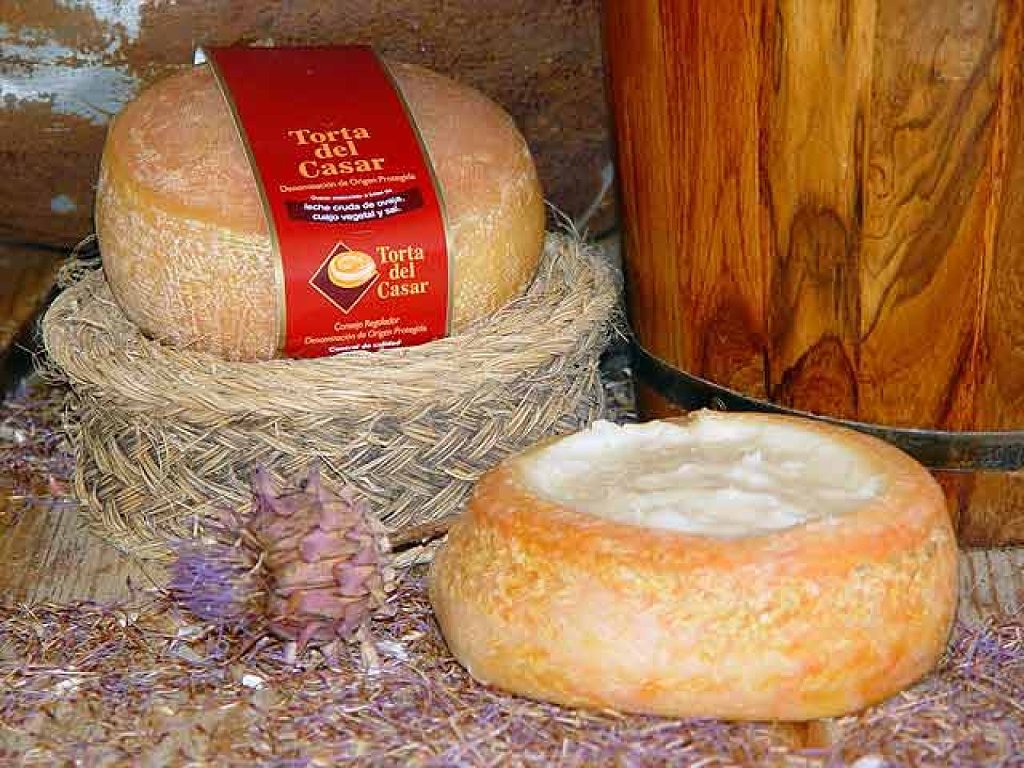
Torta del Casar PDO is a Spanish cheese made from raw sheep’s milk in the Extremadura region, near the Portuguese border. Named after Casar de Cáceres, its city of origin, the shepherds who made the cheese used to call it ‘atortao’ because it was shaped like a cake or ‘torta’. Torta del Casar is a very rare cheese since it is made from milk of Merino and Entrefina sheep that yield very low milk and it takes a herd of sheep to make 1 kg of the cheese.
Torta del Casar is a vegetarian product coagulated with cardoon, a wild thistle which adds a slightly bitter note to the rich and slightly salty tasting cheese. The cheese is aged for at least 60 days upon which it develops a semi-hard, yellow to ochre crust and a soft, spreadable, creamy, almost runnier paste. Its insides are yellowish in colour and the aroma very unique. Torta del Casar should be enjoyed as an appetizer or a dessert, spread on bread with a glass of dry, red wine.
Queso de Valdeón
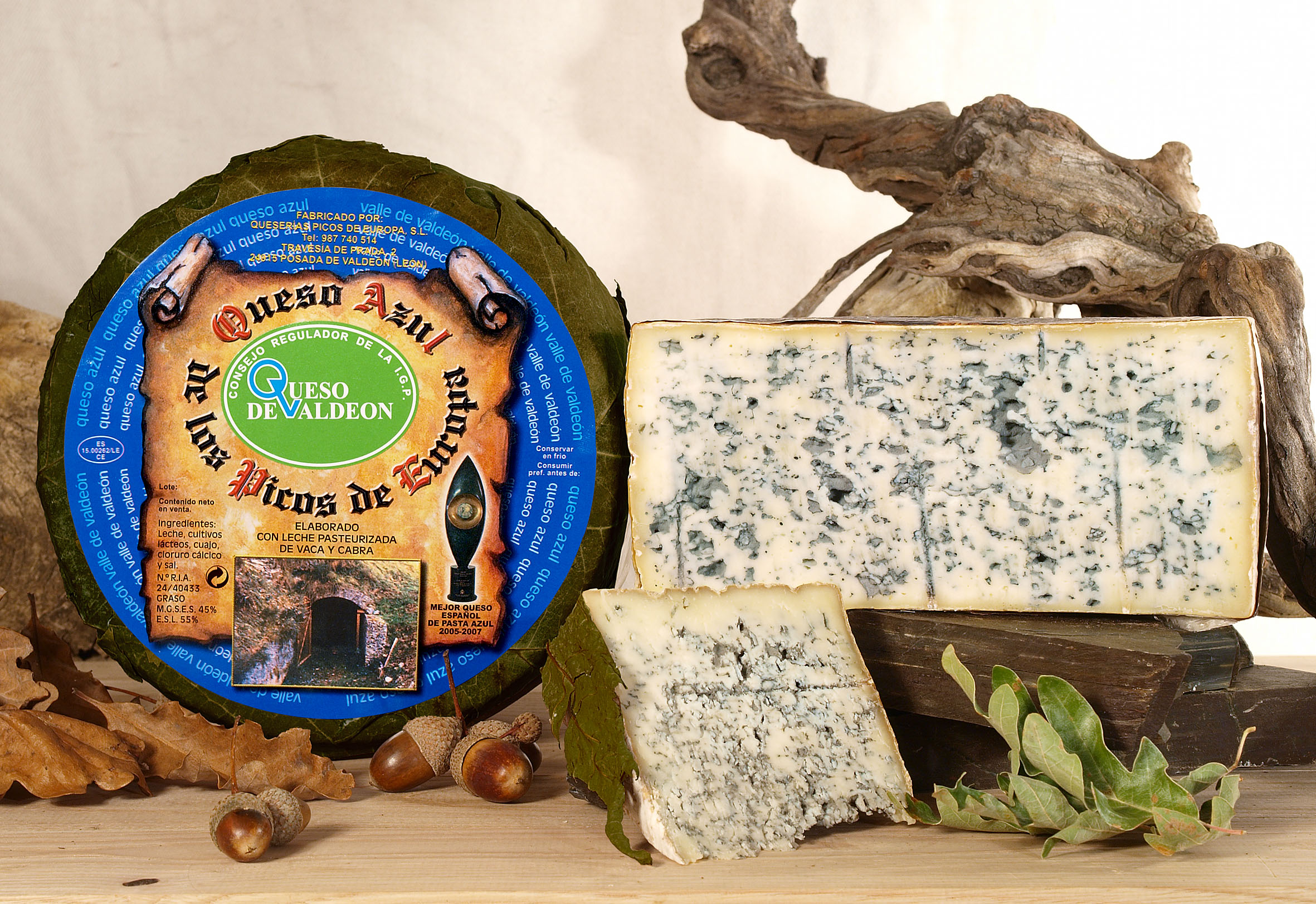
Valdeon is a Spanish blue cheese produced in Valdeon Valley of Castile-Leon region of northwestern Spain. Made all year round with cow or goat’s milk or a mixture of both, the cheese has very dense blue veining and comes wrapped in maple or chestnut leaves. Since leaf wrapping is no more allowed these days, it comes wrapped in leaf printed aluminium foil. Queso di Valdeon has been awarded a status of Protected Geographical Indication (PGI) to regulate the production, processing and preparation of the cheese. In 2005, the Ministry of Agriculture, Fisheries and Food granted the cheese an award for best Blue Veined Spanish Cheese.
A bold and salty cheese, Valdeon uniqueness lies in its manufacturing process, which includes long and traditional maturing in the cold, damp cellars until the cheese reaches a mature or medium mature age. The pate of Valdeon has a soft, granular texture and pale yellow colour and is full of small cavities filled with blue moulds. Covered by a coarse, inconsistent rind in dark grey shades with little red marks, Valdeon is very strong and spicy in taste similar to Roquefort. A powerful smelling cheese, Valendon's greasy, buttery paste is perfect for preparing any kind of blue cheese sauce. The rich smell of the cheese makes a good companion for fresh fruit and strong red wine or sherry.
Queso Gamoneu
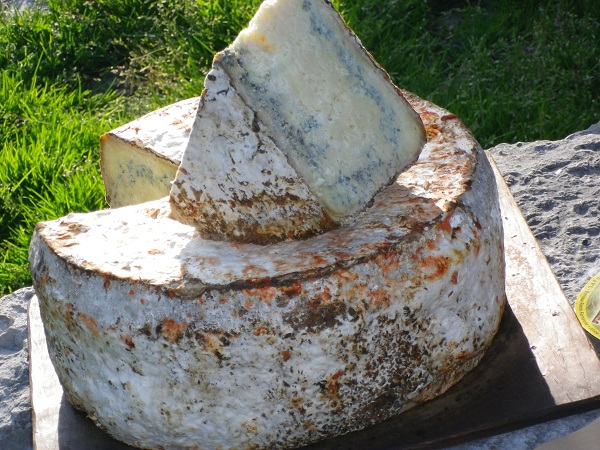
Gamoneu or Gamonedo is a Spanish PDO cheese produced from a blend of cows, sheep's and goat's milk. Originating in the high altitude areas of Asturias, there are two varieties of the cheese depending on the location where it is made and seasonal production. Gamoneu made from June to September in the cabins of Los Picos de Europa and Cangas de Onis is called Gamonéu del Puerto. On the other hand, Gamonéu del Valle is made in small dairies in the lower areas of both these councils all year long.
Gamonéu is a fatty cheese with a yellowish-whitish pate and greenish-bluish Penicilliun outcrops on the edges. Its thin rind is a distinctive sienna colour acquired during the smoking process. Texturally, Gamonéu is hard or semi-hard, firm and friable with small, irregular eyes scattered spread throughout the pate. The taste is slightly spicy and smoky with a buttery, nutty persistent aftertaste. Its aroma is clean with soft hints of smoke that intensify with maturation.
Queso Idiazábal - smoked
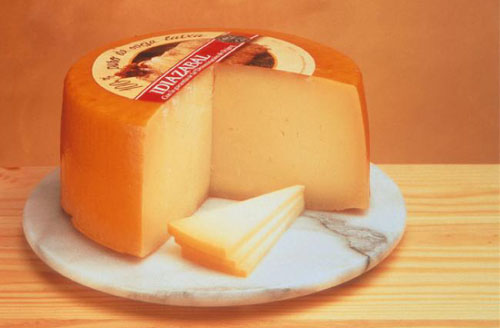
Idiazabal is a traditional, farmhouse, hard cheese made from raw milk of Latxa or Carranza sheep in the Basque and Navarra regions of northern Spain. Named after the village of Idiazabal, the cheese received Spanish D.O. (Denominacion de Origen) in 1987.
In summer, the sheep migrate to higher pastures to graze on the blossoming, new grass. During this time, the artisanal cheesemakers milk the sheep, make the cheese and leave it in the rafters to mature. At the end of summer when the cheesemakers return back to the lowlands with their sheep, the cheese has ripened and is ready for sale.
Idiazabal is produced in the shape of a cylinder, with a smooth and hard natural rind that is pale yellow to amber in colour. The cheese has a compact texture, with a few pinprick holes. It is dry, but not crumbly, and feels pleasantly oily in the mouth. The rind carries the marks of the wooden moulds in which it was drained. The characteristic, smoky flavour is the result of the cheeses having been stored near the fireplaces. There were no chimneys in the simple mountain huts, so the cheeses absorbed the sweet, aromatic smoke. The taste of the cheese is reminiscent of burnt caramel and bacon. It pairs well with red wine and cider.
Queso Tetilla
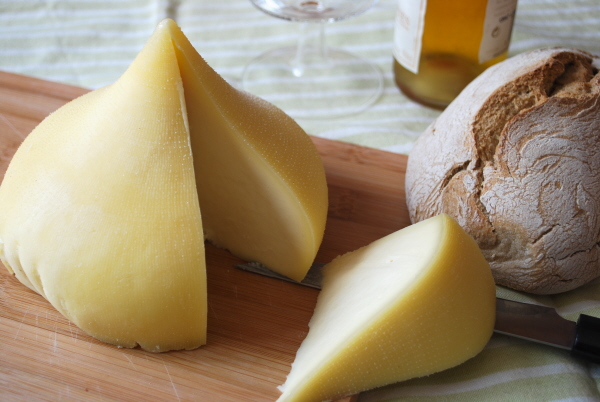
Tetilla is a typical Galician cheese made from the herd of Friesians, Alpine Browns and Rubia Gallega cows. Since 1992, it has been one of the four kinds of cheese that received DOP recognition. The name Tetilla is Galician for “small breast”, which describes the shape of the cheese – a pear-shaped cone topped by a nipple.
This cheese has a pale yellow, thin, natural rind or sometimes no rind can be seen at all. Its texture is soft, thick and smooth with scatterings of air pockets. Yellowish ivory in colour Tetilla has a creamy mouthfeel with buttery, slightly bitter and tangy flavours surrounding the palate. The maturing, which takes place between 10 and 30 days, happens in the hot and humid climate of Galicia.
Try Tetilla with a dry full-bodied wine, sherry, young whites, manzanilla and especially the Galician whites - albariño or Ribeiro. Spanish love their cheese with quince paste, fruit, crackers, baked dishes and bread.
Queso de La Peral
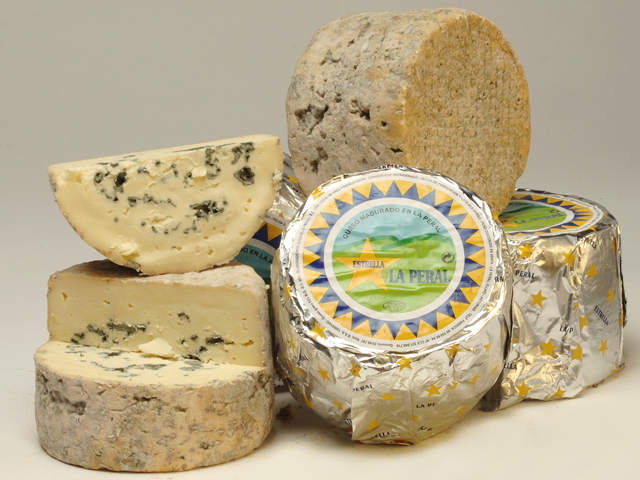
La Peral is a gently blued pasteurized cow and sheep milk cheese from Asturias in northern Spain. This rare and delicious cheese has been produced for a little over a century. The sheep milk component gives this firm cheese a little olive oil flavour and a pleasantly pungent aroma. Also known as Queso Azul Asturiano, La Peral is made by the Lopez Leon family. The wheels are aged for sixty days just to the point that the blue begins to develop. La Peral resembles an Italian Gorgonzola. It has a slightly crumbly texture that leads to a refreshing finish on the palate. Along with other bigger wines, we recommend that you try pairing this outstanding blue cheese with Tempranillos, Cabernet Sauvignons, Gamays, Ports or Spanish dessert wines.
Queso de Los Beyos

Los Beyos is one of our speciality cheeses from Asturias, aged for 2 months and made from pasteurized cow`s milk. Los Beyos is truly an artisanal beauty produced in the mountains of Amieva. It takes its name from "el desfiladero de los Beyos". This place is a beautiful but extremely narrow and curvy mountainous area in Asturias that follows through into Castilla-Leon. There is a constant debate as to which specific area in Asturias is where this cheese originated. Dense and compact. Rustic and artisan. We hope you find the texture and flavour as interesting and as much as a rollercoaster ride as we do. The cheese itself is drier and flakier but still retains a cured and rich flavour with a sharpness that does not linger for very long. And good news! Los Beyos pairs just as nicely with a Martini as it will with Chardonnay and Tempranillo.
Queso Zamorano
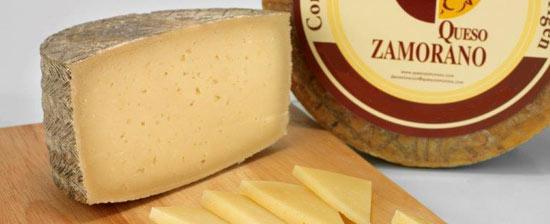
Zamorano is a famous Spanish sheep’s milk cheese made in the region of Castile-Leon, Zamora. This hard cheese takes almost 6 months to mature fully. It has a pale-yellow colour with a crumbly texture and contains 45% fat.
Zamorano has a buttery and nutty taste, which is served as a table cheese with White, Red as well as Zinfandel wine. It gets characteristic flavour because of the breed of sheep – the small, scruffy Churra and the Castilian sheep.
Due to a distinctive zigzag pattern and cylindrical shape, Zamorano appears similar to Castellano or Manchego.
There you have it, 10 fantastic cheeses from Spain that must be savoured if you are a cheese fanatic!